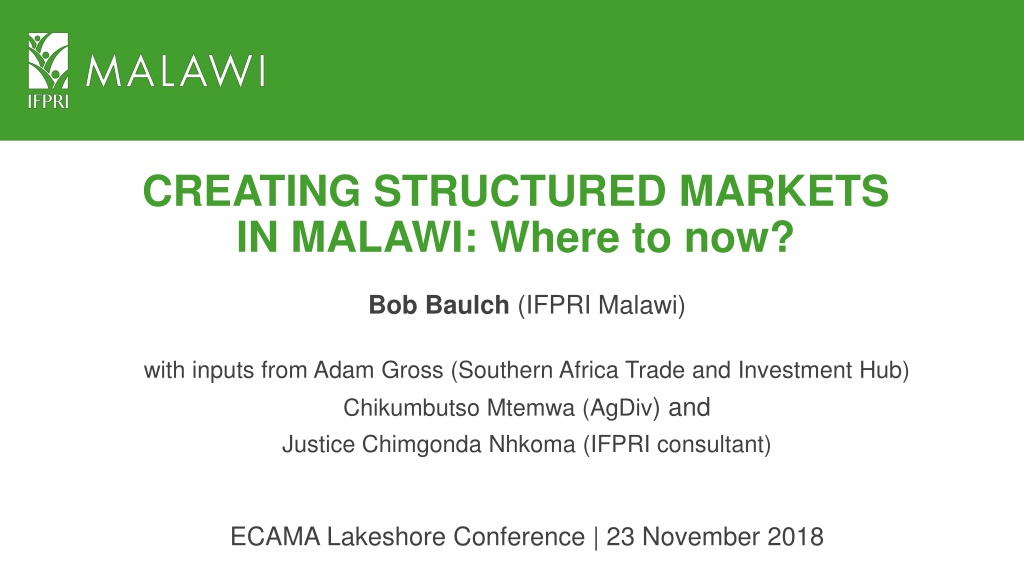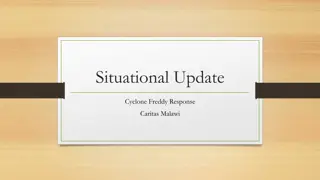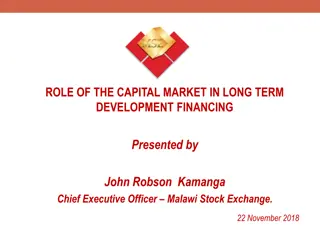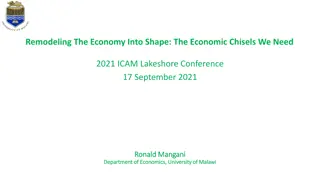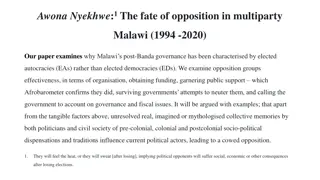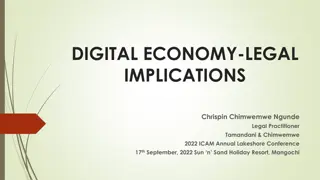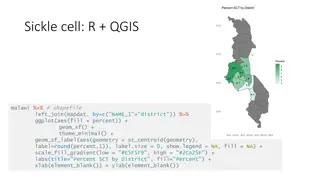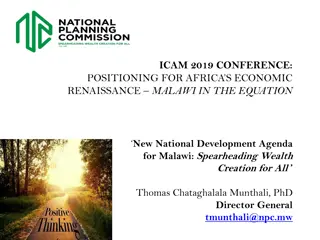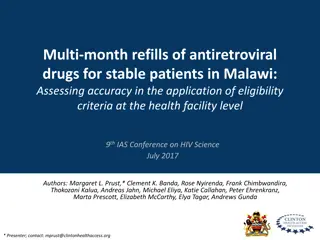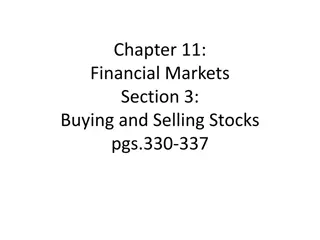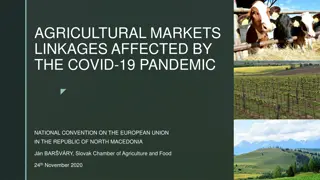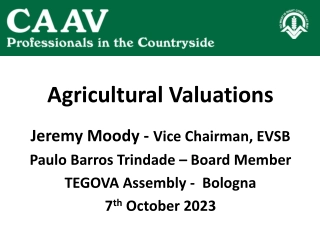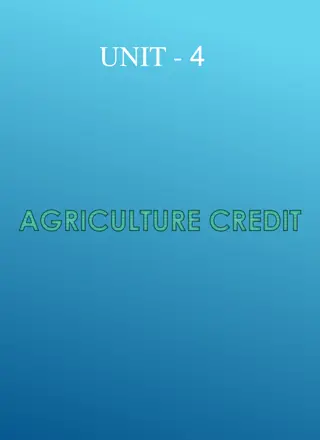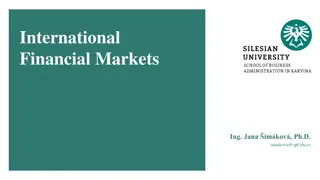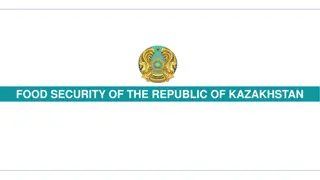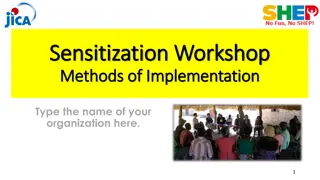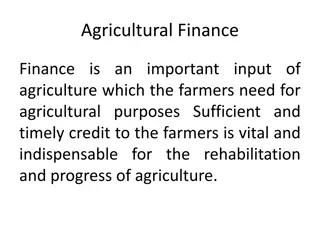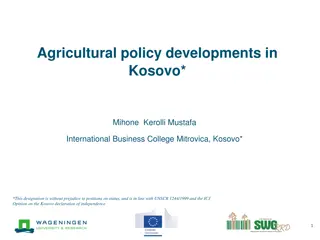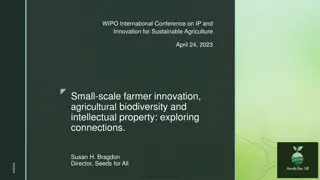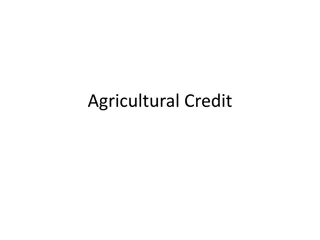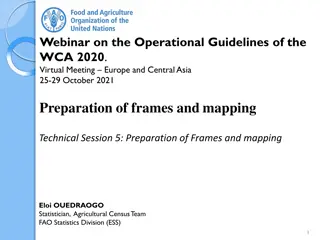Structured Markets in Malawi: Maximizing Agricultural Exchanges
Study conducted to enhance performance of Malawi's agricultural commodity exchanges and warehouse receipts, analyzing international experiences, lessons learned, and recommendations for optimizing market structure and benefits.
Download Presentation

Please find below an Image/Link to download the presentation.
The content on the website is provided AS IS for your information and personal use only. It may not be sold, licensed, or shared on other websites without obtaining consent from the author. Download presentation by click this link. If you encounter any issues during the download, it is possible that the publisher has removed the file from their server.
E N D
Presentation Transcript
CREATING STRUCTURED MARKETS IN MALAWI: Where to now? Bob Baulch (IFPRI Malawi) with inputs from Adam Gross (Southern Africa Trade and Investment Hub) Chikumbutso Mtemwa (AgDiv) and Justice Chimgonda Nhkoma (IFPRI consultant) ECAMA Lakeshore Conference | 23 November 2018
Introduction Study for DFID and USAID which aimed to understand: the landscape in which Malawi s two agricultural commodity exchanges and warehouse receipts operate; how best to maximize their performance and benefits to key stakeholders
Methods Review of International Experience Interviews with 45 key market participants in May to July 2018 including: ACE and AHCX Farmers Associations/Cooperatives in 11 districts Small and Medium Scale Traders in 11 districts Processors and feed manufacturers Large National Traders and National Food Agencies Financial Institutions Analysis of secondary data (where available) from Malawi & other African Comex Questions on use of Comex added to IFPRI survey of 3000 farm households and to structure-conduct- performance study of maize marketing
Lessons from International Experience (1) North America and Europe Historically most Commodity exchanges (Comex) developed from forward contracts with negotiable warehouse receipts open outcry trading floors electronic trading platforms Established Comex have market participants (brokers and market makers ) who do not exist in most developing countries Derivatives trading (futures, options) forms the bulk of trade (physical deliveries on futures contracts is very rare)
Lessons from International Experience (2) Latin America Like North America, Comex and WR developed in parallel Unlike North America, warehouses and WRS were Government-run Transition and Developing Countries Have tried to develop comex based on spot (auction) markets. Many of these attempts have failed Most successful Comex have been in large countries
Africas Experience with Comex Only two well-established Comex in Africa: South African Futures Exchange (SAFEX) now part of the Johannesburg Stock Exchange Ethiopian Commodity Exchange (ECX) SAFEX is the only derivatives-based exchange in Africa ECX is government established and promoted exchange, made financially viable by export mandates on coffee and sesame Most other African Comex are nascent or thinly-traded
Volume and Turnover on Selected African Comex Turnover (US$ millions) 2016 Turnover (US$ millions) 2017 Volume (MT) 2016 Volume (MT) 2017 Exchange Volumes (turnover) on the other 14 African commodity exchanges is collectively less than 150,000 MT (US$ 52 million) SAFEX, S. Africa 130,700,000 128,600,000 68.1 40.8 ECX, Ethiopia 669,877 672,980 1,034 1,311 AFEX, Nigeria 47,780 28,377 15.1 12.4 EAX, Rwanda 15,000* TBC ACE, Malawi 60,232 16,373 24.6 3.8 AHCX, Malawi 48,756 3,622 17.5 TBC Sources: African Development Bank 2018; ACE, AFEX, AHCX, ECX, SAFEX Note: * 2015
Alternatives to Commodity Exchanges Forward contracts through large commodity traders (Cargill, Continental, ETG, Farmers World) are commonly used by processors And large traders can use future contracts on established Comex to hedge price risks Direct collateral financing of physical stocks is available from commercial banks for processors and large traders. Comex-backed WRS financing must compete with direct collateral financing. Vertically integrated supply chains (nucleus estate and contract farming) provide many of the benefits of Comex without the need for an exchange
Preconditions for Establishing a Comex Jayne et al. (2014) identify five of these: 1. A pre-existing vibrant spot market; 2. The potential to achieve sufficient volume traded across the exchange to cover its fixed costs; 3. The presence of ancillary marketing services being offered which enable a commodity exchange to be instituted at relatively low cost; 4. Modes of institutional governance and appropriate incentives sufficient to motivate rapid learning on the part of the Comex s management; 5. A commitment from government to desist from unpredictable and discretionary forms of intervention in commodity markets. Q. Were any of these conditions met in Malawi in 2006 or 2013? A. Not really
Malawis Commodity Exchange Landscape Established 2013 Followed an alternative model: investing heavily in e-trading infrastructure and exchange-owned warehouses followed by high profile launch ACHX is a fully commercial platform owned by Auction Holding Ltd and enjoys considerable government support Established 2006 Followed the traditional model: gradually diversifying from physical spot auctions, to an electronic bulletin board, to a WRS with certified warehouses, to forward contracts. ACE and ACE Trust are not-for-profit and have received substantial donor support ACE and AHCX trade similar commodities and offer similar products (spot and forward contracts plus and WR financing) but have different geographical coverage
Volumes Traded on ACE and ACHX, by commodity and year ACE ACHX 90,000 90,000 80,000 80,000 70,000 70,000 60,000 60,000 Volume (MT) Volume (MT) 50,000 50,000 40,000 40,000 30,000 30,000 20,000 20,000 10,000 10,000 - - 2012 10,472 8,549 515 336 53 2013 34,718 5,364 3,777 171 54 2014 12,548 2,637 7,520 104 3,263 2015 79,435 4,768 3,403 99 1,395 2016 42,768 2,768 6,858 4,256 3,583 2017 11,724 554 2,755 317 1,024 2013 254 85 593 594 2014 4,167 1,803 788 951 2015 5,683 9,750 2,607 777 2016 46,596 987 852 322 2017 217 225 2,093 1,087 Maize Pigeon peas Soya Sunflower Other crops Maize Pigeon peas Soya beans Other crops
Perspectives of Farmers Associations/Cooperatives 11 of 18 farmers associations/coops interviews had traded on a Comex at least once (but none of 3,001 farmers interviewed in parallel survey had) Trust in Comex s equipment (esp. scales) and expertise in commodity storage Link to financing via WRS valued However: Strong preference for cash-based spot transactions Costs regarded as high compared to spot sales to traders by 80% of farmers associations Costs of handling and storage are not transparent Collapsing prices in late 2016 have deterred many from using WRS again Most farmers associations have only traded on Comex once or twice A (politically) independent body is needed to regulate the Comex
Perspectives of Traders Two-thirds of small traders are unaware of the Comex Those that aware of them, generally do not sell to the Comex High charges and fees, distance to warehouses, and grading issues (esp. for rice) deterred many small traders from using the comex Most small traders strongly prefer cash-based transactions Larger traders use the Comex to supplement their established direct marketing channels Most large traders have their own warehouses but use WRS to obtain collateral financing or supplement their own warehouse capacity Withholding tax an issue or some large traders
Perspectives of Processors/Feed Manufacturers Frequent default on spot contracts on ACE and AHCX Forward contracts more reliable Contract farming and vertically-integration of supply chains offer alternative to Comex for securing supplies Processors with their own warehouses can obtain direct collateral financing more cheaply than through WRS, and therefore only use WR financing occasionally Comex registered warehouses also used to supplement processors own storage during peak procurement season Some processors like ACE s ability to structure forward contracts in accordance with Islamic banking principles
Perspectives of Financial Institutions Seven financial institutions (FI) have offered collateral-based financing via the Comex (mostly haircut financing of WR) in the last five years Two FI have experienced substantial defaults on such loans, despite attempts of marking to market with physical margin calls Direct collateral financing is also offered to large traders/processors by most commercial banks Comex backed WRS preferred to direct collateral financing by some banks, as no need for expensive collateral managers Warehouse Receipt Act of 2017 now provides legal framework for recovery of non-performing loans
Perspectives of Food Agencies Use Comex periodically for procurement of supplies in bad years Procurement via Comex (usually BVOs) regarded as more transparent than direct procurement (by NFRA or ADMARC) BVO auctions have not performed as expected benefiting large traders and rarely reaching farmers associations Believe that Comex can help stabilize farmgate prices (this is dubious with current volumes/turnover!) Little use/appreciation of the value of forward contracts (let alone options on futures)
Legal framework When both ACE and AHCX were established, Malawi had no legal framework to govern their operations beyond general contract law. Warehouse Receipt Act enacted in late 2017 RBM s Commodity Exchange Directive, approved 3 April 2018, will come into force on 27 April 2019 Interviews with financial institutions and different market players, indicate that the provisions of the WR Act and Comex Directive are not widely understood Nonetheless the Act and Directive provide a solid legal basis for the development of Comex
Summary and Conclusions Like many other Africa Comex, the volumes and turnover on Malawi s two Comex are low and volatile Larger traders use the Comex and WRS to supplement their established direct market channels and warehouse facilities Food Agencies/DPs have unrealistic desire to use the Comex to increase/stabilize prices received by farmers Unrealistic for financial institutions to demand physical margin calls on WRS (haircut) financing Systemic problems with collateral management and own account trading Comex and WRS are NOT the answer to everything
Where to now? Recommendations: quick wins Harmonize ACE and AHCX s grading systems Promote storage using WR to farmers associations/small traders without linking them so closely to collateral ( haircut ) financing To limit financial exposure, commercial banks should set strike prices (triggers) for sale of stocks and establish term limits for collateral-based loans (whether backed by official WRS or other forms of receipts) Promote collateral management as an alternative income stream for Comex to commissions and fees (Note: this requires indemnity (or fidelity) insurance.) Comex should strictly enforce regulations on own-account trading in Commodity Exchange Directive (by both themselves and their employees)
Recommendations: Medium-term + Some Controversial Proposals Medium-term Rationalize ACE and AHCX operations to promote synergies and reduce overlaps Offer ZAMACE/JSE futures contracts on Comex in Malawi Set-up a single, independent WRS for Malawi Some controversial proposals Establish an independent body to oversee the Comex ACE and AHCX should merge into a single exchange Remove withholding tax on food commodity transactions>MK60,000
Full report downloadable from http://massp.ifpri.info/ Acknowledgements Financial Support: Data and Inputs: AgDiv, AGRA, AIMS, East African Grains Council, DCAFS, GIZ, NASFAM, Nicholas Minot (IFPRI), Southern Africa Trade and Investment Hub
Some Key Terms Auction: a process where potential buyers place competitive bids on assets or services Basis: the difference between the spot price and the futures price of a commodity Commodity Exchange: A legal entity that determines and enforces rules and procedures for the trading standardized commodity contracts and related investment products. Derivative: a financial instrument, such as a futures or options contract, whose value is based upon a physical commodity (or on other financial instruments) Collateral Manager: A company that ensures the integrity of warehouses and the quality of commodities held therein Forward contract: A private, cash-market agreement between a buyer and seller for the future delivery of a commodity at an agreed price. (Unlike futures contracts, forward contracts are not standardized and not transferable.) Future contract: a standardized contract for the purchase and sale of physical commodities (or financial instruments) for future delivery on a regulated commodity futures exchange. Hedging: Taking a position in a futures market opposite to a position held in the cash market to minimize the risk of financial loss from an adverse price change Marking-to-market: to debit or credit on a daily basis an account based on values the close of that day's trading session. Options contract: a standardized contract that gives the bearer the right, but not the obligation, to buy or sell a futures contract at a specified price within a specified time period Spot market: a market physical commodities are bought and sold for cash and delivered immediately Warehouse receipt: a document which guarantees the quantity and quality of a commodity stored within an approved facility Sources: https://institute.cmegroup.com/support/glossary and www.investopedia.com
Key References ACE (2016 and 2017) Our Past Present and Future AfDB et al. (2018) Africa s Commodity Exchanges, Warehouse Receipts Systems and New Standards, Mimeo AHCX website Edelman et al (2014) Strengthening storage, credit and food security linkages: the warehouse receipt system in Malawi MaSSP Working Paper 14, IFPRI Malawi Gondwe & Baulch (2017) The Case for Structured Markets in Malawi . Policy Note 29, IFPRI Malawi Jayne et al. (2014) Agricultural Commodity Exchanges and the Development of Grain Markets and Trade in Africa , IAPRI Working Paper 88 Rashid (2015) Commodity Markets and agricultural development: what have we learned? Mimeo, Triennial Conference of Int. Ass.Ag.Econ, Milan UNCTAD (2009) Warehouse Receipt Systems and Inventory Credit in Eastern and Southern Africa, Mimeo Williams, J.C. (1986) The Economic Functions of Futures Markets, Cambridge University Press
